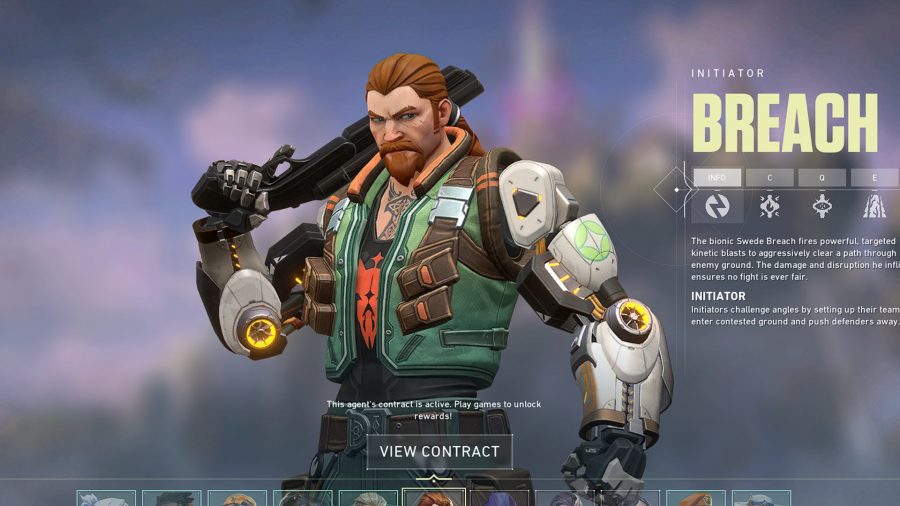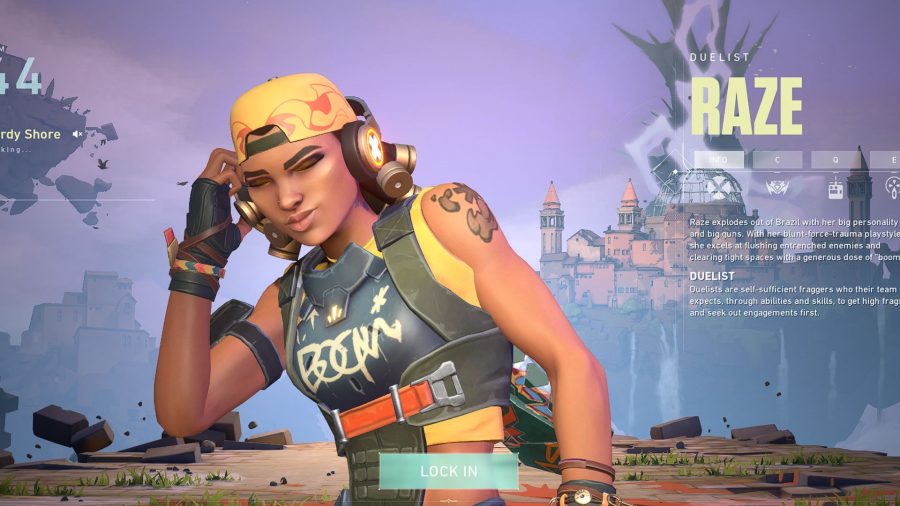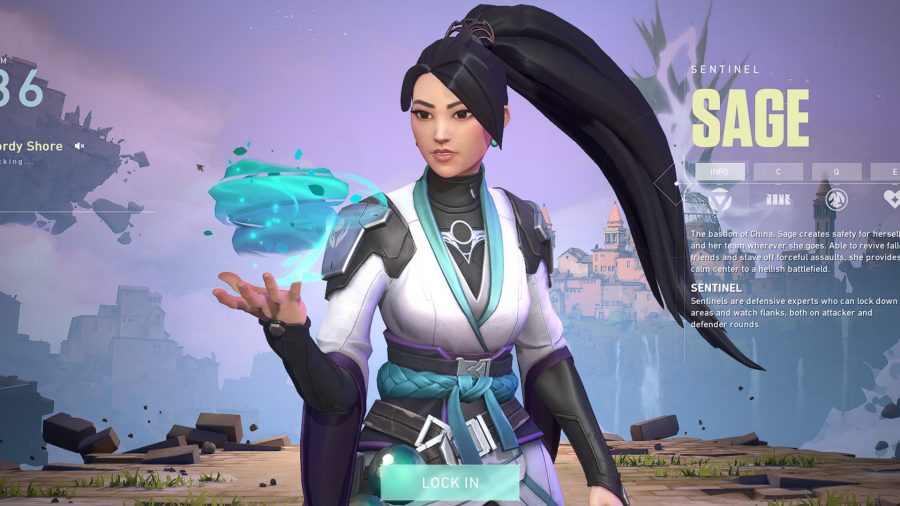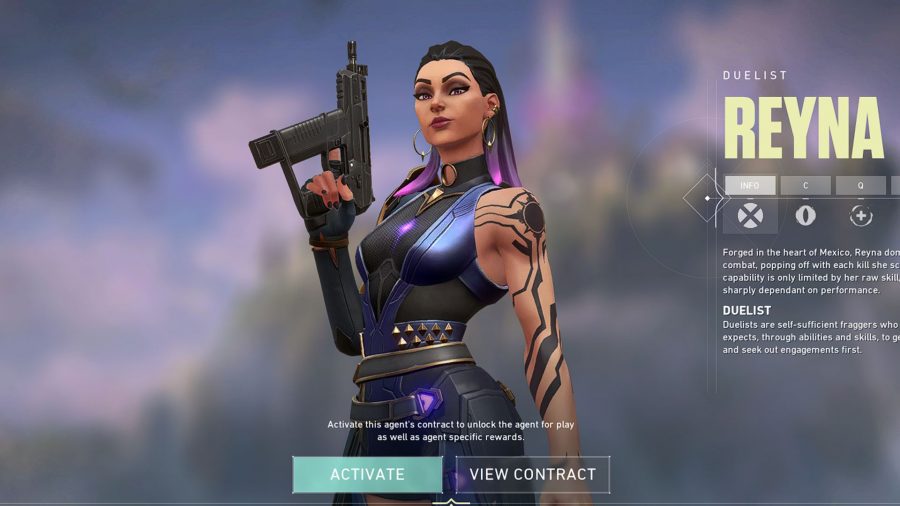Our Valorant tier list isn’t for the highest elo or solo-queue heroes, instead we’re ranking all of the Valorant characters based on their potential effectiveness in the average ranked match. We always suggest playing with at least two or three friends so you can actually string some strats together, hence why you won’t spot hard-carry agents like Reyna near the top of our list.
This tier list also takes the current meta into consideration, so while some agents are very powerful on paper, you’ll find their abilities hard to use in ranked because of how most team’s generally play. Utility is essential in Valorant and can make the difference between securing a plant and getting trapped in spawn, so smokes, delaying utility, and corner-clearing flashes are generally what separate S-tier from C-tier. Anything that counters Operator plays is good in our books.
If your team is trying to figure out what comp they should be running in ranked then hopefully our Valorant ranked tier list will help you out. We’ve done our research tuning into pro streams and dying countless times over in ranked play so you don’t have to.
The best Valorant agents are:
Cypher
Omen
Jett
Breach
Sova
Killjoy
Phoenix
Raze
Brimstone
Sage
Reyna
Viper
S TIER
CYPHER
Cypher’s recon utility is a little too easy to predict and destroy if you’re not switching up placement every round, but codename Gumshoe is an incredibly powerful agent in the right hands. In the current meta Cypher is unmatched when it comes to locking down a site, even compared to Killjoy.
Although it’s a nuisance at low elo, the Tripwire is easily Cypher’s weakest gadget as it can be easily avoided by slow walking, possibly even providing your team with a false sense of security. When it works, and when you place it at the right spot so it can’t be avoided, it either slows an opponent and pings their location, or it forces them to reveal their location by shooting it. It’s still a great tool for reading the enemy team, which is half the battle in Valorant.
Cypher’s ultimate is a little more ‘feast or famine’ as it relies on Cypher being near a downed enemy, but it can be a round-saving ability if it confirms the site is clear for you to plant on or reveals the last couple of enemies hiding in corners ahead of you.
Cypher’s camera allows him to continually check back on an angle and get a read on whether the opposite team is stacking or rotating. This can also be used aggressively to scan corners for enemies before pushing onto site, and is especially helpful for post-plant scenarios where the Cypher can sit somewhere safe and make calls for the rest of their team.
Cypher’s cages are particularly handy for aggressive play as they also slow enemies moving through them – they can be chained together so you can make huge flanks straight through site. Because the cages also make a noise when an enemy moves through them, they stop enemies pushing through the smoke, which can be an issue with Brimstone.
Ultimately, Cypher’s abilities allow you to rotate between sites more confidently, safe in the knowledge that you’ll know if the enemy changes tack. He’s also the only agent who can solo-hold a site, gathering intel with his camera and stalling out pushes with cages and Tripwires. He’s essential on defence and versatile enough to help out on attack.
OMEN
Omen’s ability to move around the battlefield without being spotted and feint moves makes him incredibly difficult to read, forcing enemies to second guess anything you do. He can quickly move between cover in the heat of battle without exposing himself, blind and deafen huge areas of a site with his flashes, and cut off important Operator angles with his precise smoke placement.
While Paranoia is one of the weaker flashes in Valorant, it still offers your team a quick and direct means of pushing a chokepoint. The precision of his smokes, coupled with the fact that they can be placed from anywhere on the map means he’s unmatched when it comes to quickly adapting strategies and selling fake pushes. You can also create a number of one-way smokes that allow you to see the enemy without them seeing you, which is very powerful for stopping site pushes dead in their tracks or getting free kills.
At high elo Omen’s teleport ult is more useful as a recon tool as most good teams will be able to locate you and trap you in place. In a clutch situation you can easily use it to teleport to the other site and secure a plant, making Omen superb in 1v1 fights.
JETT
Jett is an agent for players who want to take big risks but are confident they can hit their shots. She’s fast, nimble, and can escape practically any situation. The best Jett players are sharp with her blade-throwing ult, can navigate the arena quickly, and who can use the Operator or Judge.
Her kit is all about movement: she can hover, dash, soar into the air, and throw down clouds that obscure vision for a few seconds. In the hands of a skilled player a Jett can zoom straight onto site, carving up the defense and allowing the rest of the attackers to clean up. Her dashing ability encourages playing in unconventional and unsafe spots, as you can get a shot off and retreat immediately. Jett’s ult invaluable in the hands of a skilled aimer, especially if you unleash it on an eco round.
More guides like this: Here are the best Valorant guns
She doesn’t really add much to a team in terms of utility, but her ability to twist the knife when flooding a site is unrivalled. With more and more delay utility entering the game, Jett’s ability to simply dash through them makes her a unique threat when defending. Check out our Jett guide for help getting to grips with this agent.

A TIER
BREACH
Breach’s abilities are very, very powerful, but in a meta that heavily favours Operator users, his flashes are a little too difficult to use across long angles as you have to set them up through map geometry. This is only of the only reasons he’s not in S tier.
Recent buffs have granted Breach an additional flash, made his flashes stronger when they’re off-screen, and made them quicker to deploy, so Breach now has more usable utility, and plenty of it for breaking through to site. In addition, Breach’s Rolling Thunder also got buffed so that it deploys faster, and – best of all – its concussive effect will now de-scope players and prevent them from scoping until the effect wears off.
If you want to push onto a site using shorter angles then Breach is virtually unrivalled. His range of lethal attacks, flashes, and disruptor abilities can make life for corner-campers very unpleasant, either eliminating them outright, making them powerless when you push, or forcing them out into the open.
Breach’s kit is versatile for practically any scenario, and they work well as both supporting abilities and for direct fights. Aftershock, for example, can be used to guarantee a corner is clear on attack, or as an easy stalling ability when defending as it does so much damage that players will always avoid it.
Going back to his flashes, Breach’s Flashpoint ability is in most scenarios the best flash utility in the game and will provide a quick but lasting flash effect that’s easy to set up in close-quarters fights, unlike Phoenix’s bending flashes. However, this is a lot less useful for long angles where finding the right geometry isn’t always possible.
Breach’s Fault Line signature ability isn’t quite a flash, but it does disorient, slow, and even hinder the rate of fire for any players caught in its area of effect. This, effectively, makes them useless. In many ways, it’s better than Flashpoint, so when you roll the two together it’s easy to see why Breach is so strong at set play scenarios.
SOVA
Sova is a pure reconnaissance agent, although his ultimate is handy for netting some free kills. In the right hands, and with a memory bank of Recon Bolt lineups, you can get a read on how many enemies are stacked up on a certain site. His Shock Bolts are useful for clearing out traps, chipping enemies with damage, and halting pushes, and his Owl Drone can be used as a follow-up to the Recon Bolt to gain intel on any areas the bolt couldn’t see. All of this makes Sova equally viable on attack and defence, and the best agent in the game for supporting a push onto site.
Sova, so good: Here are our top Valorant Sova lineups
Finally, there’s Sova’s ultimate, which can be used with map pings to deliver deadly blows to key map positions like heaven and window. Even if you can’t land a kill with the three arrows, you should at least be able to flush the enemy out of position so your team can clean them up.
KILLJOY
Killjoy joined the Valorant roster at the beginning of Act II with a bang, bringing a whole host of new intel opportunities and traps players have to look out for. Her main benefit is that her gadgets allow her to collect information without risking her own neck. In fact, her introduction was so explosive she was banned at the pro level. So how come Killjoy isn’t in S-tier?
With a recent nerf making her frankly ludicrously punishing Nanoswarm grenades easier to spot, less damaging, and less immediate she’s had a significant reduction in lethality. Her turret, while still superb for trading off and gaining intel, was never particularly threatening, and her Alarmbot fulfils a similarly lukewarm role in the gadget meta, so this change hits her where it hurts.
Killjoy’s toys: The best placements for Killjoy’s Turrets and abilities
Despite this, the Nanoswarm will still punish aggressive pushes, lazy default plants, and will still need to be cleared out, so we’re not counting killjoy out just yet. Especially when her Lockdown ult is still capable of singlehandedly opening up a site for the attacking team.
PHOENIX
Phoenix, much like Jett, is lethal in the right hands, but doesn’t offer quite as much team play potential as our S tier picks.
Phoenix’s flashes can go horribly wrong if you time them incorrectly or misjudge the distance, flashing your team at a critical moment. But in the right hands, Phoenix can use them to push onto site solo as the ‘weapon-ready’ time is much faster than with Breach’s flash, which often requires a second player to execute properly.
Phoenix’s wall also makes him very strong, especially on attack, as it allows him to completely block line of sight and create a corridor for the attackers to walk onto site through. This can be used in combination with the flashes to stall and delay enemies so you can safely rotate, too.
Finally, there’s the molotov ability and Phoenix’s ult. The molotov isn’t as powerful as Brimstone’s but it is slightly more versatile as it can be used as a healing pool for Phoenix – but it’s main use is to clear out tricky spots and block angles off temporarily. There is arguably no stronger ult in the game than Phoenix’s, which gives you a free life to bulldoze the site with, gathering intel and sometimes even earning a free kill. Most players will simply run when they hear this ult being popped, so it can be a great way to force an entry.

B TIER
RAZE
Raze gets a lot of flack for being too simple and only useful for picking up cheap frags with her Paint Shells cluster grenades and rocket ult. However, she’s one of the strongest agents for clearing utility in Valorant. In most ranked matches she’s used only as a fragger though, a role she’s simply good at, rather than great or dominant, hence her placement in B tier.
Her Paint Shells and Blast Packs can be lobbed into default Tripwire and Nanoswarm spots in order to clear out utility and buy a quick path onto site. On defence these same abilities are handy for slowing down pushes.
Raze’s Boom Bot can be deployed for intel-gathering and corner-clearing, and it’s also a simple, efficient means of distracting the enemy team, allowing you to swing out and get a shot off. A great example of this is when pushing hookah on Bind where a well-placed Boom Bot can clear out both left-hand corners.
Raze’s most undervalued piece of utility however, is her Blast Packs. These joyously versatile satchels can be thrown and detonated for a range of results. The most obvious is that you can throw these down and use them to elevate to a higher position or to quickly push or escape an enemy – this is often used with Raze’s ult to gain vision on a site before firing a rocket. However, high elo players are also using Blast Packs as mini grenades to flush out any corner campers.
BRIMSTONE
Brimstone might be a boring agent to play but nobody opens up the attacking playbook quite like him. Being able to drop long-lasting smokes without line of sight, right at the start of the round, is unparalleled when it comes to rushing onto site. This utility aside, Brimstone’s molotov is also incredibly powerful for denying plants or stopping defenders from defusing the spike – it’s high damage and area of effect can eat up enough time for you to rotate to a new angle or close out the tense final seconds of a round. Likewise, Brimstone’s ult is a very effective means of clearing out chokepoints and keeping defenders away from the spike.
The only negative is the Stim Beacon, which grants an almost imperceptible fire rate buff, but you can simply not buy it, or throw it down as a bluff.
Brimstone used to be much higher up this list, but many players are learning that Brimstone’s utility isn’t all that powerful and can be easily countered. The molotov, for example, leaves Brimstone vulnerable for a very long time. Meanwhile, his smokes are pretty expensive when you max them out and can only be deployed within a relatively close range. All the things that Brimstone does are better served by other agents.

SAGE
Valorant’s only healer is still mighty, but after a couple of successive nerfs she’s just received the biggest one yet. Targeting her self-heal, ability to heal others, her barrier, and her slow orb all at the same time, Sage is now looking rather weak. All of her abilities take longer to kick in, so if you manage to bring her or another enemy down to low health, you now have a window of opportunity before they’re back at max health where you can rush in to finish them off. The barrier orb now spawns with less health and fortifies over time, meaning you can’t place it as reactively, and the slow orbs cover 30% less ground.
That said, she is still the only healer, and that means you can never discount her, especially as her rez ult is arguably the strongest ultimate ability in the game.
Sage advice: Here’s our complete Valorant Sage guide
Paired with some lethal equipment like Raze’s grenades, Sage’s slow orbs can still effectively guarantee a kill. The wall ability is still capable of blocking a rush, and it can also be used to elevate teammates and grant your team some fresh angles.

C TIER
REYNA
There are so, so, so many positive arguments and things to be said about Reyna’s potential and toolset, but she’s also a ‘feast or famine’ agent, and that means she’s only as good as the player controlling her. In the hands of a high skilled player in ranked she’s S-tier, but her raw utility isn’t sufficient to land her any higher than C-tier.
To her credit, Reyna’s flashes are very powerful for peaking and pushing, and her ability to chain frags together makes her the ultimate agent for clutching out rounds. Her ultimate also makes her dominant in 1v1 battles, so in the hands of a solid fragger she’s a terrifying prospect.
As all of the agents in Valorant are very well balanced, putting Reyna in C-tier is by no means suggesting she’s a bad pick.
VIPER
Viper was initially the worst agent in Valorant, but can now be used effectively in ranked thanks to some buffs to her kit.
Viper has a high skill ceiling with controller abilities that generally do a pretty bad job at, well, controlling. Most of her abilities do chip damage rather than actually killing enemies, so many players will simply run through her abilities and force an even fight. Being able to throw her walling ability through geometry makes it much easier to set up and more versatile, but it still doesn’t do enough to deter enemies from just walking through it. The addition of the ‘fragile’ debuff to Viper’s Snakebite means players take it more seriously, and it’s more effective on eco rounds.
Her giant smoke cloud is still a powerful ability, but only having one means she can’t be subbed in for a Brimstone, Cypher, or Omen. It’s also worth flagging that Viper’s ult still doesn’t offer the team much and is only really valued for clutching a post-plant.
Overall, dedicated Viper players will be able to wring some value from her toolkit, but most of her abilities are simply weaker versions of abilities used by other agents.








0 Comments:
Post a Comment
If you have any query please let me know